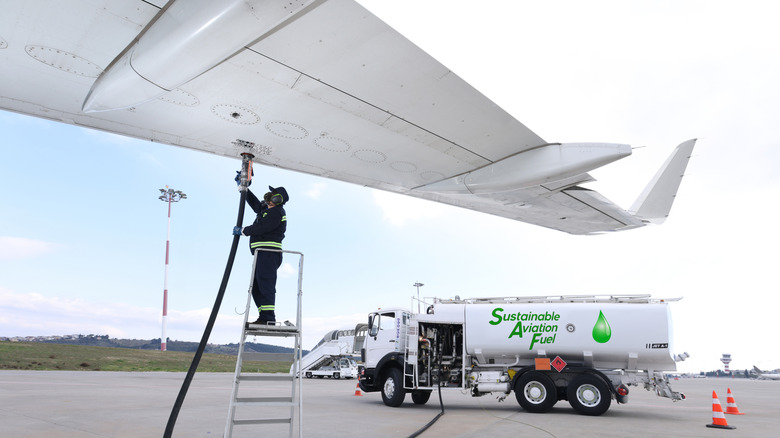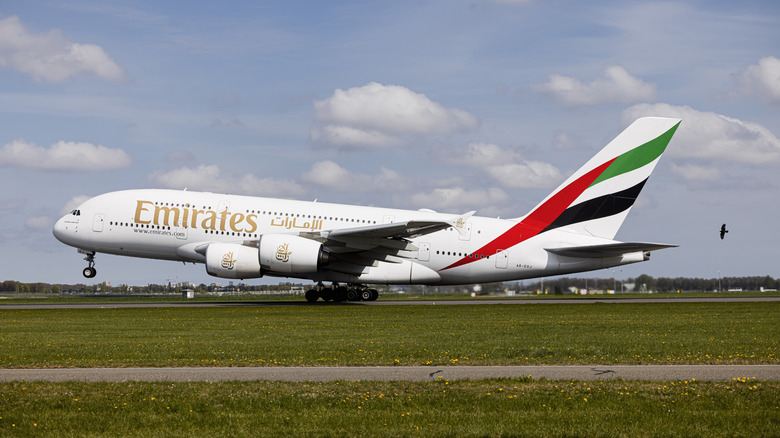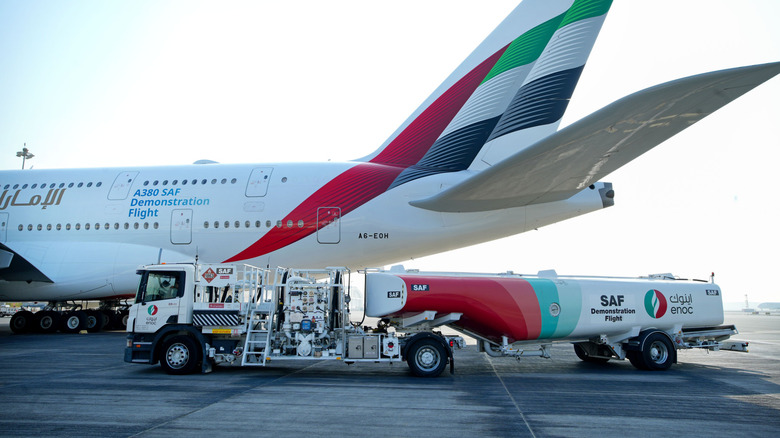Why Commercial Jets Don't Fly With A Full Tank Of Gas
Packing up for a long trip in your car usually means making sure your tank is full, but this logic doesn't fly in aviation. Commercial jets rarely take off with a full tank of fuel, and it's not because the pilots forgot. Rather, the decision is deliberate, calculated, and very much by the book.
Each plane, depending on the model, has a strict maximum takeoff weight (MTOW) it can't exceed. This weight is a combination of passengers, cargo, and fuel. Overloading a plane isn't just inefficient, it's unsafe and, in many countries, illegal. Fuel happens to be heavy at about 6.7 pounds per gallon, and the more you carry, the more you burn just to carry it. That creates a vicious circle where extra fuel ends up costing more than it saves.
So pilots and airlines calculate fuel needs carefully before each flight. They consider the distance, expected weather conditions, and passenger load. Federal regulations also mandate contingency fuel, which is usually enough for an alternate airport and an extra 45 minutes in the air. But even with this buffer, it's rarely necessary to top off.
More fuel means more weight and more problems
Fueling an aircraft isn't just about reaching the destination — it's a balance of physics, safety, and profit. Short- to medium-haul jets like the Boeing 737 or Airbus A320, which carry around 150 passengers, fly shorter distances and therefore require less fuel. This often allows them to maximize passenger load without breaching weight limits. Larger aircraft like the Boeing 747 or Airbus A380, designed for long-haul routes, are equipped with much bigger tanks and can seat upwards of 470 to 580 people. But even these giants with their significantly more powerful engines aren't free from these shortcomings. If they're fully booked, they usually can't fill the tanks to capacity without exceeding the maximum takeoff weight.
That's why airlines and pilots calculate the minimum amount of fuel required for a flight, including reserves, rather than going all in. Even weather gets factored in. For example, strong tailwinds might allow for slightly less fuel, while poor weather could require pilots to take on extra. Air traffic congestion is another factor.
Fuel is also an expensive commodity: In 2023, the aviation industry spent a staggering $271 billion on fuel, a figure only risen over the decades. So it's no surprise that there's a financial side to all this, too, where airlines try to spend as little as possible on fuel. That said, it can sometimes make sense to fuel up extra at cheaper airports — fuel can vary by several dollars per gallon across locations.
Sometimes, planes can even let fuel go mid-air
While it's rare, there are cases where a plane must lighten its load fast. That's when fuel dumping, officially known as fuel jettison, comes into play. It might sound wasteful or dangerous, but it's a safe, engineered solution for emergencies. These emergencies can include medical issues or maintenance concerns, and may force the plane to land early. The problem here is that jets are built to land at much lighter weights than they take off with. Landing fully loaded risks serious structural damage.
The solution to this is fuel dumping. It isn't standard practice, though, and only wide-body jets like the Boeing 747 or Airbus A350 have the systems to do it. Smaller aircraft like the Boeing 757 or A320 don't even have that option. In such cases, pilots either circle in the air to burn off excess fuel. Landing overweight can also be an option, but it may lead to inspections and possible repairs afterward.
When fuel is dumped, it's usually done between 5,000-6,000 feet and over unpopulated areas, where it disperses and evaporates before reaching the ground. The environmental impact is surprisingly low, given how rare these incidents are.


